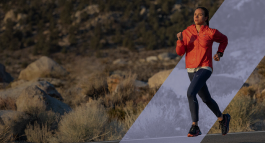What to look for when choosing a waterproof jacket
October 23, 2021
It can be really difficult to choose a waterproof jacket for running, cycling or walking. Hopefully, we can answer some of your questions and make the decision-making process a bit easier for you.
It can be really difficult to choose a waterproof jacket for running, cycling or walking. Hopefully, we can answer some of your questions and make the decision-making process a bit easier for you.
We’ll help you to understand the technology that lies behind the best waterproof jackets and highlight other considerations, such as weight and comfort, that you may be wondering about.
Waterproof coat technology
Whether you are looking for a waterproof jacket for work, cycling, climbing, walking or running you’ll find the same technology will be used to make your coat waterproof.
So, how does a waterproof jacket work?
The technology has to balance the need to keep rain, wind and snow out while maintaining breathability. After all, the last thing you will want if you are exercising in the rain is to have a jacket that keeps in all the heat you are generating.
The breathability of a waterproof jacket is determined by how easily it can move the heat and moisture created by you from the inside of the jacket to the outside. This must be matched by its ability to not allow the rain to come in.
Membrane or coated?
There are two main types of waterproof material used for jackets – membrane or coated. Both the membrane and coating are applied to the inside of your jacket’s face fabric. The durable water repellent finish applied to the outside of the jacket actually just supports the main work carried out by this.
A membrane is a material that has thousands of microscopic holes on its surface. These holes are too small for water to pass through but they are large enough to allow vapour out.
Membrane jackets will perform better than coated jackets, which have a rubber-like layer painted onto the inside of the fabric that creates the waterproof barrier. If you are looking to get active in all types of weather, the enhanced waterproofing and breathability of an outdoor winter waterproof jacket that uses membrane technology will be your best option.
The hydrostatic head test for waterproofing
The hydrostatic head test is the system used for measuring how waterproof material is.
A section of material is pulled taught under a sealed tube of water that is one inch in diameter. The amount of water that comes through the fabric is its hydrostatic head.
As a rough guide:
- Anything below 1,500mm will probably start leaking quickly
- Between 1,500mm and 5,000mm you will have pretty effective waterproofing for longer periods
- And from 5,000mm to 10,000mm you have some excellent waterproof gear
How should your waterproof jacket fit?
All of us come in different shapes and sizes and it’s important that your waterproof jacket fits perfectly. The fit will also be influenced by how you intend to use the jacket.
- A relaxed fit is best suited to everyday use
- An active fit is neither snug nor baggy and allows extra room for you to wear another layer underneath like a fleece
- A technical fit is a feature of waterproof hiking and climbing jackets that offer greater freedom of movement yet sit closer to the body
Whichever fit you are looking for, you should be aware that men’s waterproof jackets have longer arms than ladies’ waterproof jackets: if you can't find a ladies’ jacket that fits perfectly, it may be worth trying on the men’s equivalent.
Lightweight waterproof jackets
The weight and size of your waterproof jacket is something else to consider, particularly if you are a runner looking for a lightweight waterproof jacket.
Fortunately, fabric technology now allows the manufacture of quality waterproof and breathable jackets that are super lightweight and can be easily compacted.
For example, the ASICS ACCELERATE JACKET™ weighs less than 500g but offers a hydrostatic head of 10,000mm.
Other things to consider when buying a waterproof jacket
- A well-fitted hood will completely cover your head and ears and have adjusters and wire peaks that allow you to customise the fit and ensure it stays in place in windy conditions
- You may prefer to choose a jacket that has a detachable hood (or one that can be packed away into the collar)
- Zippers should be covered by a storm flap or taped to seal out the rain
- Chin guards prevent you from scratching your lower face on the metallic zip
- Cuffs with Velcro offer extra protection
- Drawcords allow you to tailor your jacket at the waist, hood or hem.
- Dropped hems provide extra coverage from the elements at the back
- If you take your phone and music out with you, having a pocket that is designed to carry your media and headphones is going to be essential. Hikers, for example, may lookout for a larger map pocket.
- Typically found on waterproof jackets designed for more activewear, vented pits are a way to manually vent the jacket and enhance its breathability
- For use at night on roads, reflective strips can be a great safety feature
Maintaining your waterproof jacket
After all the research and thought that you have put into selecting the perfect waterproof jacket for you, you will be keen to clean and maintain it.
Caring for your outdoor gear is easy. Simply pick up a clothing cleaner and proofer to maintain the condition and performance of your jacket. By regularly cleaning and caring for your jacket you will extend its life by maintaining its condition and removing grime, oils and dirt.
